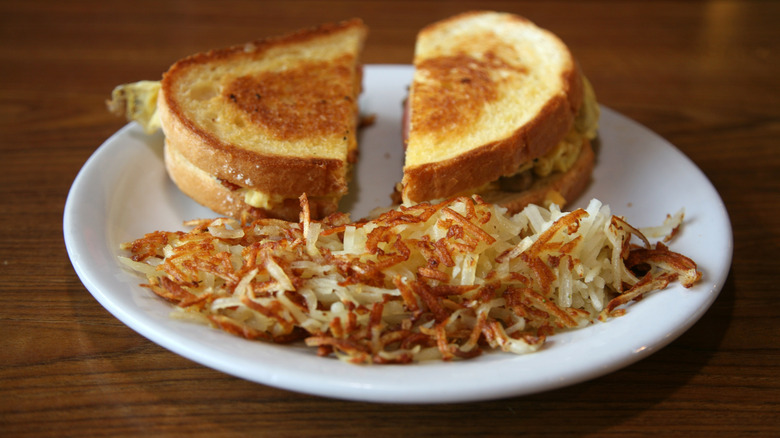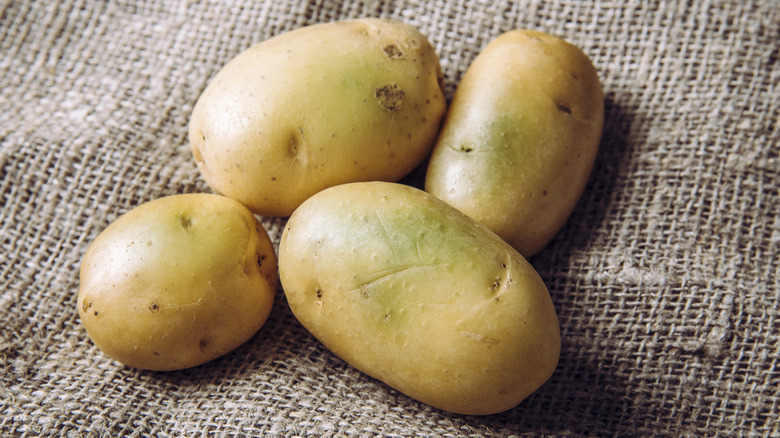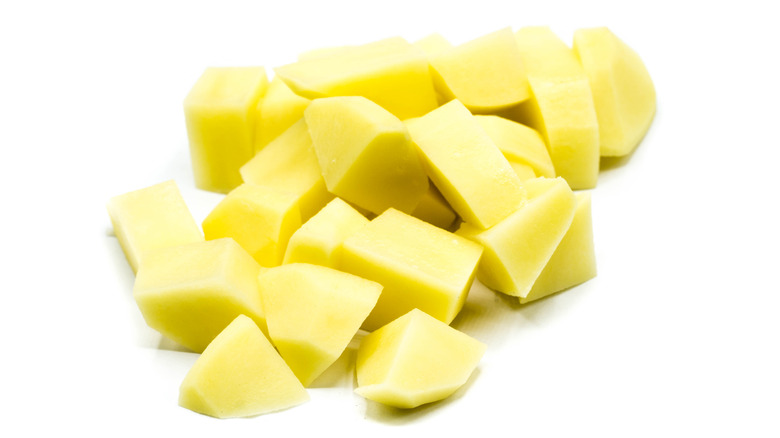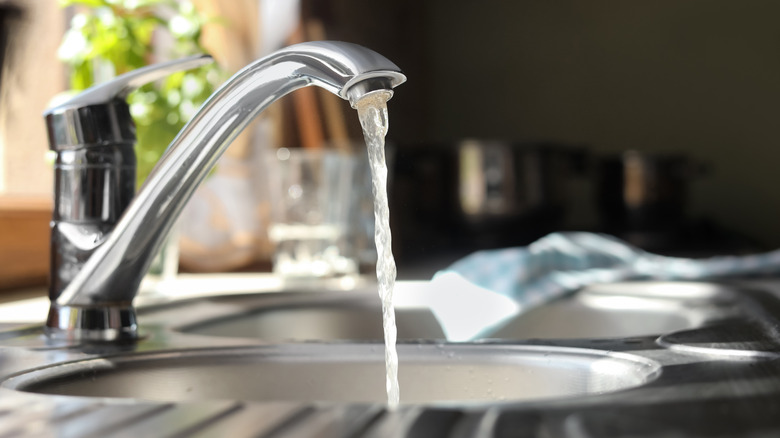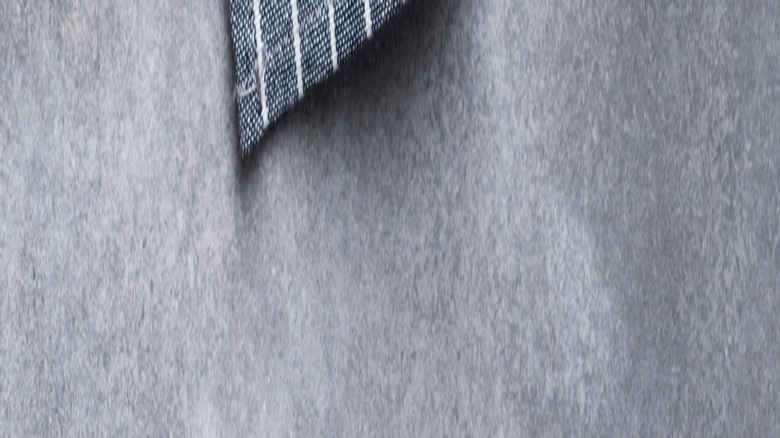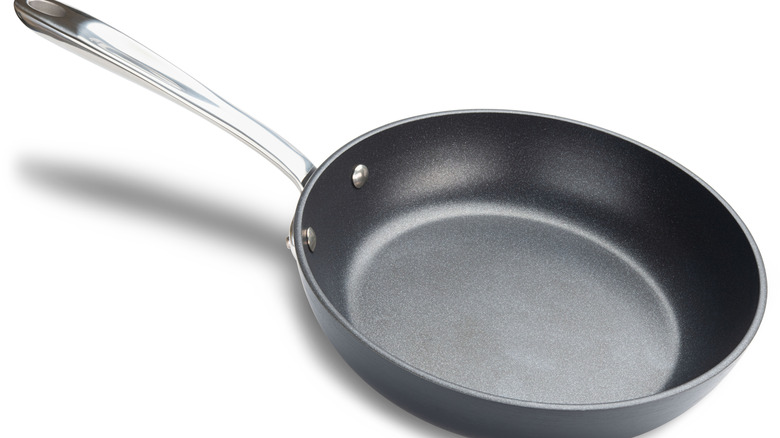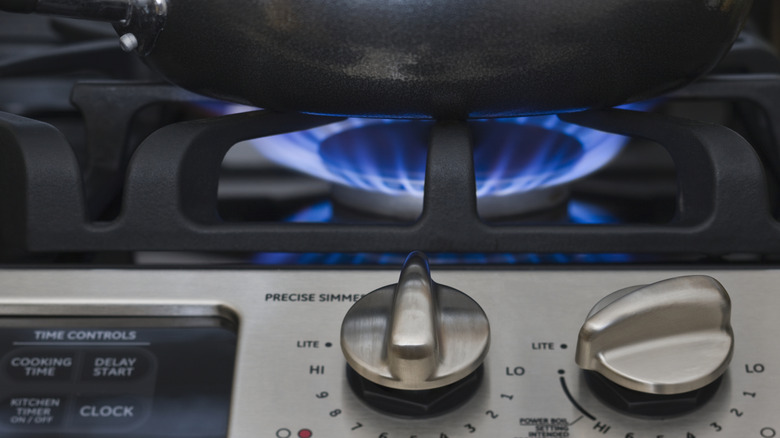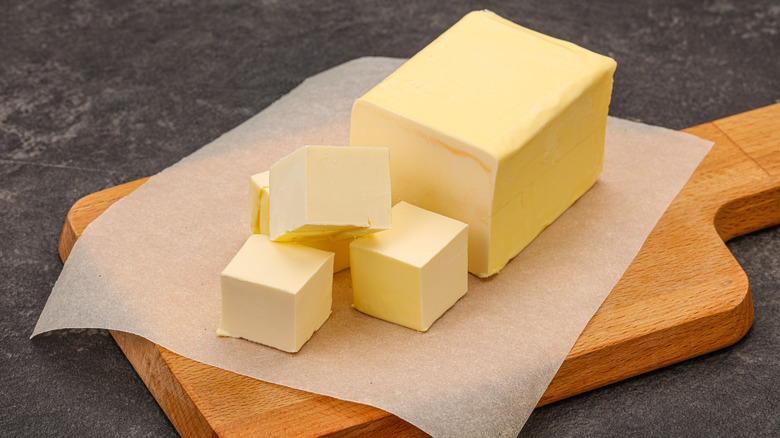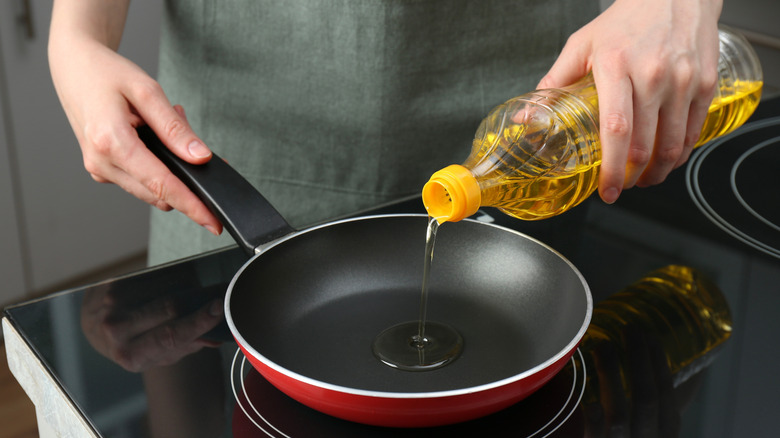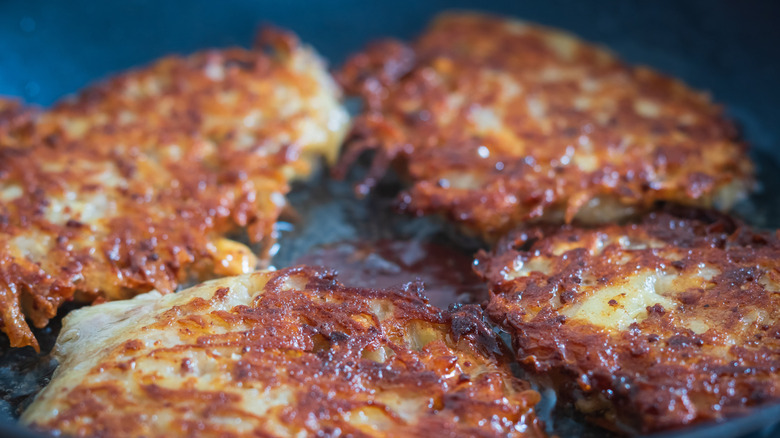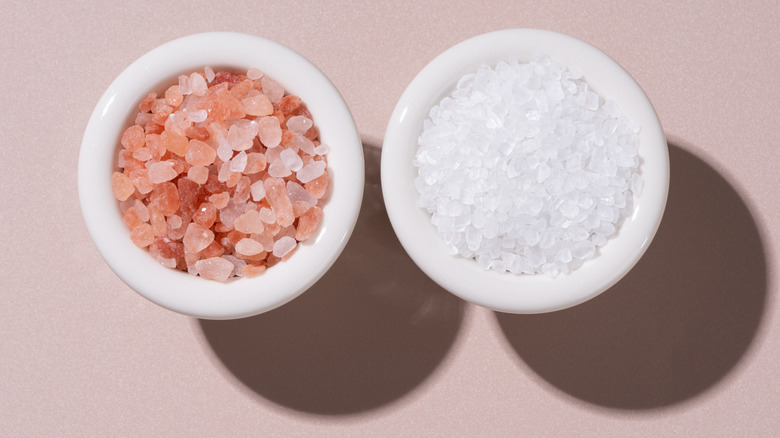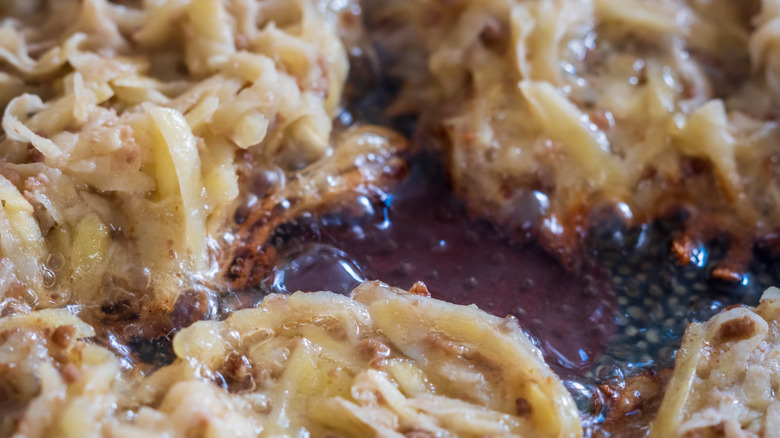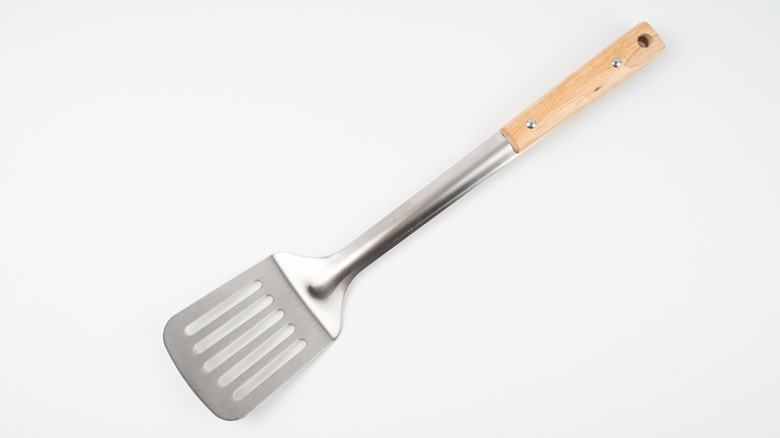12 Common Mistakes To Avoid When Making Homemade Hash Browns
We may receive a commission on purchases made from links.
Hash browns are as American as apple pie. They're delicious, which probably explains why they are a staple at every diner or brunch joint in the United States, or so it seems. They're also cheap, as russet potatoes and vegetable oil are some of the most affordable ingredients on the market today. Lastly, they're quite easy to make ... with one caveat: If you don't know what you're doing, there is plenty that can go wrong.
The good news is, there's also plenty that can go right. If you can avoid basic mistakes like using the wrong potatoes and pans, cooking at temperatures that are too high or too low, or choosing the wrong oil, you'll see much better results. Making good hash browns isn't necessarily intuitive, but once you know what you're doing, it is simple. To that end, Chowhound sat down with a few professional chefs to get the DL on common mistakes and what to do differently. Get ready to wow at your next brunch or, hey, just take tonight's dinner to the next level.
1. Using the wrong potatoes
It seems like everyone has an opinion on hash browns. From Gordon Ramsay's recipes to McDonald's hash brown patties to Trader Joe's frozen versions, they're found in every corner of public life. Despite this fact though, too few home cooks know how to make them well, and that starts with the initial step: choosing your potatoes.
Waxy potatoes might be tempting, given their buttery texture and higher level of flavor as compared to russets, but that's your first mistake right there. "As a general rule, I would say avoid potatoes with too much moisture," says Vannesa Bordoy, executive chef at Graduate Nashville. "Any kind of waxy potato will give you a soggy result. Stay away from red potatoes, fingerlings, and even Yukons, as they can all end up not being the right call."
The right potatoes for hash browns are russets. They produce reliably crispy results because they contain more starch and less moisture than waxy potatoes. When choosing spuds, avoid the ones that are green, which indicates the development of solanine, a bitter and possibly harmful compound if eaten in large quantities. Also, Seed to Sprout chefs and co-owners Alex Mazzucca and Cara Duerr note, "Potatoes that have sprouted or have black spots should be avoided if possible. You always want to look for nice firm clean skin."
2. Cutting potatoes into the wrong shape
Hash browns and home fries are not the same thing, even if some people confuse them (yours truly didn't know the difference until she was like 20, which is embarrassing). The problem is, if you don't get the right shape of potato, then you disrupt the intended cooking process of hash browns. Instead of a crispy batch, you will get a soggy, oily mess, or best case scenario, just a different result.
"You don't want big chunks of potato, so avoid thick french fry-style cuts or big cubes, as it will hurt the process for crispy hash browns," Vannesa Bordoy advises. Instead, say Alex Mazzucca and Cara Duerr, "You want your potatoes to be cut as finely as possible." In addition to french fries and cubes, avoid rounds. Shredded potatoes lead to hash browns with the right texture, because the potatoes cook through easily and provide lots of available surface area for crisping up. There are many ways to shred them well.
A high-quality grater can help here, because sharp blades will make the job go faster. If you really want to speed it up and have a few bucks to drop on becoming a hash brown expert, then you can always get a food processor, which will give you perfect strands in a matter of minutes. If you already have one but don't know how to do this, look for the grater insert and read the instructions; you'll be shocked at how easy it is.
3. Forgetting to rinse the potatoes
It sounds weird to rinse potatoes, doesn't it? They're a vegetable, which we normally don't rinse after cutting. (Yes, despite what your parents told you, potatoes are vegetables.) Yet the starch content of potatoes makes them different from, say, a zucchini or a stalk of chard. If you don't get that starch out of there, your hash browns are at risk.
Why? Because starch has some unique cooking properties. While a little of it can add some nice crispiness to your baked and cooked dishes by absorbing water, too much of it has the opposite effect. If you leave a lot of starch on the outside of your potato shreds, Vannesa Bordoy says, the result will be gummy instead of crunchy. Plus, Alex Mazzucca and Cara Duerr add, an overabundance of starch makes hash browns taste off and disrupts the texture.
To rinse potato shreds, simply throw them into a mesh strainer and run water over the top, tossing gently to make sure you get between all the shreds. Then tap the strainer several times to remove excess water.
4. Failing to dry your potatoes
Forgetting to dry your potatoes prevents them from getting crispy, which is why so many home cooks are disappointed by their hash browns. "In the same way not rinsing them can lead to an excess of starch that ends up making a gummy hash brown," Vannesa Bordoy explains, "an excessive amount of moisture will stop the hash brown from developing that crispy crust we are looking for."
Therefore, Alex Mazzucca and Cara Duerr recommend: "You want to make sure your potatoes are nice and dry before making your hash browns so that they aren't mushy and stay crisp." As with latkes or potato pancakes, the key is to properly dry them by wringing the shredded potatoes out with a towel. Pull them from the sieve and place them on a regular dish towel — or two if you're making a large batch. Twist the towel up into a classic rails-riding hobo bindle, then squeeze it out over the sink. If they're still wet, get new towels and do it again.
5. Using the wrong pan
The subject of which pan to use for which dish could fill entire cookbooks. Many chefs have strong opinions on what works best, and home cooks who are unfamiliar with tried-and-true materials such as cast iron or stainless steel feel an extra sense of trepidation when they contemplate using them. Unfortunately, the truth is that the best pan for hash browns is a well-seasoned cast iron skillet. Its smooth surface is ideal for distributing heat and creating good crunch without sticking.
"We recommend using a heavier pan, so your oil doesn't burn quickly, like cast iron or stainless steel," advise Alex Mazzucca and Cara Duerr. "You want to steer clear of aluminum or Teflon, whenever possible." Beware, though: Stainless steel can't be seasoned, so if you're not confident in its use, choose something else. In general, says Vannesa Bordoy, "Pans that will stick to the potato are a no-go," so avoid unseasoned cast iron.
If you haven't yet made the jump to cast iron, do it. Not only do chefs recommend it, but every home cook I've ever talked to who has committed says that it's a truly inimitable cooking tool. Having spent the last 20 years using a 10-inch Lodge cast iron skillet and its 15-inch counterpart, I can confirm that it is absolutely worth it. Best of all, these pans come pre-seasoned, so a year of steady cooking will get them in great shape. And vice-versa: Cooking high-oil dishes such as hash browns will improve the seasoning. Cooking with oil helps bake carbonized oil into your pan, which gives you that smooth-as-glass finish.
6. Setting the wrong temperature
This breakfast food is versatile as heck. You can throw frozen hash browns into the air fryer, use them in the ultimate breakfast burrito, or even put them in a breakfast sandwich as McDonald's should. None of this works very well, though, if you don't get the texture and consistency of your potatoes right. Neither reheating frozen hash browns nor putting them in a breakfast burrito or sandwich will be very satisfying if they are mushy, lacking that oily crispiness that we associate with a really good batch.
The correct temperature for frying hash browns is around 350 F, which is medium heat. Any lower, and "The potato will confit, instead of forming a crust, meaning it will absorb all of the fat and fall apart," Vannesa Bordoy says. Alex Mazzucca and Cara Duerr agree: "Frying at too low will lead to super greasy hash browns instead of light and crispy. They will also be soggy and not golden at all."
That said, don't go too high in your fear of mushiness. "I feel like in the search for creating that nice crispy crust, over-frying is more common, resulting in burnt potatoes," Bordoy warns.
7. Using the wrong fat
Fat is fat is fat, right? Sadly, wrong. There actually exists a staggering variety of traits in different types of oil, from vegetable to peanut to olive and beyond. Add in butter and ghee, and you've got a real guessing game on your hands. Happily, there are answers.
First off, it's important to understand smoke point, which is the temperature at which a fat will burn. At this temperature, the oil visibly starts to smoke, indicating that it is breaking down. "Regular butter will burn too fast and the same goes for olive oil — both have too low of a smoke point," Vannesa Bordoy says. For that reason, "You always want to use a higher-heat oil when cooking hash browns, so we would recommend using avocado oil as an example and avoiding ones like olive oil," Alex Mazzucca and Cara Duerr advise.
Avo and veggie oil can both do the trick, as they have higher smoke points. If you don't have a good source of avocado oil or vegetable oil, or don't feel like hoofing it to the store for a single ingredient, you can easily buy them online. Peanut oil also has a high smoke point, but the flavor is pretty intense, so it's best avoided unless you like Nutter Butter hash browns. Vannesa Bordoy recommends bacon fat too, which adds incredible flavor. Lastly, if you really crave your dairy, opt for ghee. The removal of milk solids means it also has a high smoke point.
8. Getting the amount of oil wrong
There are, shockingly, two ways you can go wrong with oil: using too much or too little. When you use too little, there isn't enough fat to properly distribute heat to the potatoes and crisp them up. It's tempting to try and lighten up breakfast foods, especially rich ones such as hash browns, but too little oil will lead to burning and undercooking. "You typically want your hash browns about halfway submerged," Alex Mazzucca and Cara Duerr say. This can be a bit hard to measure when you're first learning, as you are not supposed to add the hash browns themselves until the oil is hot. If you stick to a recipe, you will have a much easier time hitting the correct oil-to-potato ratio.
Conversely, adding too much oil is also a problem, as you risk simmering the hash browns in oil rather than frying them. If you're worried about going overboard, Vannesa Bordoy advises adding it bit by bit until you hit the proper amount: "During the process, fats can be added gradually but are very hard to remove after the fact," she says. Although you may not get the most optimal results the first time around because you are adding room-temperature oil to hash browns as they cook, this is better than overdoing it and fully submerging your potatoes from the start.
9. Crowding the pan
There are two main approaches to hash browns: potato pancakes and a uniform round layer. You can choose either one, but in both cases, you must avoid crowding the pan. The thinner you can get them, the crispier they will be. When the pan is too full, you are forced to build a thicker layer of potatoes in order to fit everything in. This challenges the oil to actually permeate the potatoes and crisp everything up, because you end up smashing the shreds against one another, so oil cannot get in.
"This can end up in two extremes for the cooking process," Vannesa Bordoy says. "There will be areas that are overcooked as well as potatoes that are still hard, developing both gummy parts and even burnt ones." Yummy ... said no one ever.
Alex Mazzucca and Cara Duerr note that "They will also take longer to cook if there are too many in the pan." While it might seem like a time-saver to load up all the potatoes into the pan at once, you're better off doing two batches. For a low-key brunch with friends or family dinner night, consider serving people in batches. Or you can keep them warm on a cookie sheet in an oven set to 200 F.
10. Salting incorrectly
When to add salt is a matter of contention for cooks. The reason there's so much variation has less to do with opinions, however, and more to do with the fact that the advice varies based on the food. For hash browns, the main issue is that if you haven't fully dried the shredded potatoes before salting them, the salt will draw out moisture and make for soggy hash browns. Plenty of cooks, however, are fine with salting them along the way; if the potatoes are dry enough, it shouldn't matter.
Whatever you do, always make sure they're well-seasoned before serving. "Our favorite trick with making hash browns the most delicious is finishing them with a sprinkle of flaky salt once they are removed from the heat," Alex Mazzucca and Cara Duerr say. "Golden and perfectly salted is just how we like them."
11. Moving the potatoes before flipping or flipping too soon
Under-frying: Don't do it — and yet, this happens all too often. Potentially out of a fear of burning, "It seems that under-frying is the most common mistake when cooking hash browns," opine Alex Mazzucca and Cara Duerr. "Whether the oil is not hot enough, or they are flipped too soon, you'll end up with soggy and pale hash browns, rather than golden and crispy ones." To avoid under-frying, the first step is to choose the right temperature: 350 F, as discussed. Next up: patience.
Don't move the potatoes around while they're cooking, as this disrupts the formation of a nice, crispy, crunchy bottom. Press them into the pan in an even layer and leave them there during the entire cooking time: "The typical mistake people make when flipping hash browns is flipping too soon," say Mazzucca and Duerr. "You want to make sure they are nice and golden beforehand."
Most chefs know from personal experience that it's tempting to flip hash browns just to check things out, but you only want to turn them once. Instead of messing with them, allow them to cook for 5 to 6 minutes, then check after a crust has formed. The second side will usually go quicker, around 4 minutes. The exact cooking time depends on your stove, cookware, potatoes, and so on, but use these times as a guideline to start.
12. Using the wrong spatula
Spatula, schmatula ... how much can it really matter? Turns out, a lot. The right spatula is one that is thin enough to get under the entire crispy layer and slide it off the pan. Thicker spatulas tend to scrape off the tender inside of your hash browns and leave the nice crispy part sitting on the bottom of your pan. No, thanks.
"When choosing a spatula," Alex Mazzucca and Cara Duerr instruct, "the common mistake is choosing one that is too bulky, flimsy, or made of plastic. Our favorite spatula to use is a fish spatula." You may also see this online labeled as a fish turner. Another common problem that arises? "Especially at home, people tend to go for aesthetically pleasing instead of practical," says Vannesa Bordoy. "Get a good sturdy spatula, one that won't break on and won't melt either!"
